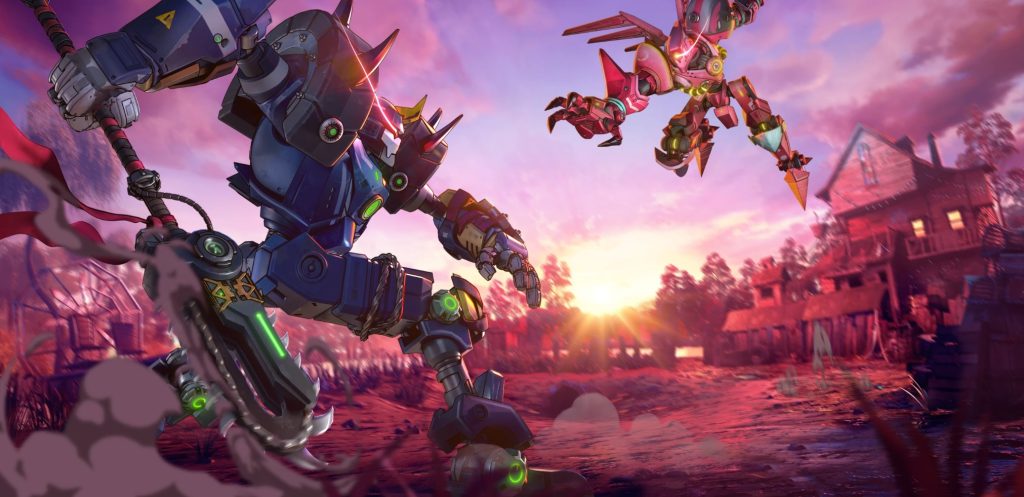
Web3 game developers and publishers are often pretty bad about explaining their products to potential players. Shoddy websites with a link to a Twitter and Discord account are more the norm than the exception. Impenetrable crypto-jargon is afforded a higher status than basic details about the games on offer.
Wreck League from nWay (a subsidiary of Animoca Brands, which also owns The Sandbox, TicBits, and Sky Mavis, among others) was announced earlier this month, and has been buttressed with a steady stream of blog posts, online explainers, and video content.
nWay’s previous games include overhead view, urban battleground Battlepalooza and head-to-head fighting games Power Rangers: Battle for the Grid, and Power Rangers: Legacy Wars. Likewise, Wreck League is a fighting game, albeit with Web3 functionality and NFT collectibles.
The San Francisco-based company has around 90 employees, and describes itself as a “developer, publisher, and tech platform for competitive multiplayer games”. Its gaming platform nWayPlay is a place to find competitive multiplayer games with play-to-earn functionality “that uses NFTs as prizes,” as well as a decentralized marketplace for collectors and gamers to buy, sell, and earn various NFTs.
Fighting talk
Games like Street Fighter and Mortal Kombat traditionally require players to select their fighter from a pre-designed roster. In Wreck League, which is based on fighting mechs, players mint various unique body parts which are then assembled in a personal garage. According to a video explainer, players use ten parts from their NFT collection to “build, deconstruct, and rebuild your mechs whenever you want”.
Mints are available to players who have registered and have at least 50 ApeCoin in their wallet (current value is $1.53). They offer players various boxes, including one that has enough inventory parts to create a mech (ten), one that includes a fully created mechs (reserved for founder-players), and others that offer supplementary parts. Parts include arms, chest, head, legs, shoulders, kneepads, satellite, and accessories.
Minted boxes yield a wide variety of parts, so players feel like they have creative choices over their fighters. Each part has its own attributes including rarity and combat abilities, all of which combines to define how the mech performs in battle.
Collection mania
The game is designed for players to buy into collections of mechs, rather than just one preferred build Players are encouraged to build multiple mechs, in order to gain entry to tournaments, and to compete for on-chain prizes. The company says it is “strategically beneficial to assemble multiple types of mechs, each optimized for different types and styles of play”.
Wreck League will start with 1 vs. 1 fights, but will eventually include 3 vs. 3 events “for which you’ll need a diverse roster of mechs to participate”. Additionally, specific types of events and tournaments will require a certain number of mechs in order to compete. “The more mechs you own, the more opportunities to engage in for better rewards.”
According to nWay, there are more than 1.5 quadrillion possible combinations of fighters for the game’s first season. Parts and mechs can be traded on exchanges like OpenSea. Parts are offered as prizes in tournaments. They include special skills like an improved energy meter, better block duration, and so on, which can either determine the player’s in-fight strategy, or reflect their preferred playstyle. “The way you design your mech is just as important as your in-game playing skills,” states the company.
Yuga collaboration
In its marketing for Wreck League, nWay claims the game is no less than “an entirely new project that marks the next chapter in the evolution of fighting games, competitive gaming, and esports”.
Season 1 is being launched in collaboration with Yuga Labs’ The Extended Yugaverse of Bored Ape and Otherside. In Season 1, Wreck League will incorporate four Yuga collections: Bored Ape Yacht Club, Mutant Ape Yacht Club, Bored Ape Kennel Club, and Kodas.
Certain mech parts featuring these brands can be assembled into Yuga mechs, or mixed and matched with regular mech parts so players can “enhance gameplay and add an element of exclusivity to their mech collection”. There are 20 mech parts for each of the four Yuga collections, so 80 parts in total that can be mixed and matched to create “an almost endless array of Yuga mechs”. More collaborations are likely to be announced for future seasons, adding to the mix-and-match nature of mech creation.
nWay is also working on free-to-play Web2 functionality which can be played by anyone, without the need for mech NFT ownership. It will also allow mech NFT owners to sell their creations as in-app purchases.
But the company is clearly focused on driving interest towards its Web3 version. “Competing with a creation you uniquely possess in a live head-to-head environment is a powerful driving force that enhances and makes the competitive gaming experience more meaningful,” states the company.
Wreck League is also being tooled for esports, with players able to build partnerships and teams, familiar to anyone who has attended or watched a fighting game tournament.
nWay’s slick and comprehensive marketing marks a shift in Web3 gaming, from the first era of often shabby, and thin NFT collection games, to a creative and competitive ecosystem that feels more solid and promising.
The company states its intent as “building a hyper-community of players, collectors, and creators … We want everyone who engages with Wreck League to explore its lore and universe, and to be inspired to generate their own player-created content, videos, artwork, and more”.
Wreck League is being launched in stages for mobile and PC. You can find out more here.
Colin Campbell has been reporting on the gaming industry for more than three decades, including for Polygon, IGN, The Guardian, Next Generation, and The Economist.
 GameDaily.biz © 2025 | All Rights Reserved.
GameDaily.biz © 2025 | All Rights Reserved.